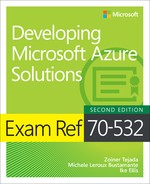Contents
Quick access to online references
Errata, updates, & book support
Chapter 1 Create and manage virtual machines
Skill 1.1: Deploy workloads on Azure ARM virtual machines
Skill 1.2: Perform configuration management
Configure VMs with Custom Script Extension
Scale up and scale down VM sizes
Deploy ARM VM Scale Sets (VMSS)
Skill 1.4: Design and implement ARM VM storage
Configure shared storage using Azure File storage
Implement ARM VMs with Standard and Premium Storage
Implement Azure Disk Encryption for Windows and Linux ARM VMs
Configure monitoring and diagnostics for a new VM
Configure monitoring and diagnostics for an existing VM
Skill 1.6: Manage ARM VM Availability
Combine the Load Balancer with availability sets
Skill 1.7: Design and implement DevTest Labs
Create and manage custom images and formulas
Configure a lab to include policies and procedures
Chapter 2 Design and implement a storage and data strategy
Skill 2.1: Implement Azure Storage blobs and Azure files
Store data using block and page blobs
Configure a Content Delivery Network with Azure Blob Storage
Create connections to files from on-premises or cloudbased Windows or, Linux machines
Skill 2.2: Implement Azure Storage tables, queues, and Azure Cosmos DB Table API
Designing, managing, and scaling table partitions
Retrieving a batch of messages
Choose between Azure Storage Tables and Azure Cosmos DB Table API
Skill 2.3: Manage access and monitor storage
Generate shared access signatures
Regenerate storage account keys
Configure and use Cross-Origin Resource Sharing
Skill 2.4: Implement Azure SQL databases
Choosing the appropriate database tier and performance level
Configuring and performing point in time recovery
Creating an offline secondary database
Creating an online secondary database
Creating an online secondary database
Import and export schema and data
Managed elastic pools, including DTUs and eDTUs
Implement graph database functionality in Azure SQL Database
Skill 2.5: Implement Azure Cosmos DB DocumentDB
Choose the Cosmos DB API surface
Create Cosmos DB API Database and Collections
Manage scaling of Cosmos DB, including managing partitioning, consistency, and RUs
Access Cosmos DB from REST interface
Skill 2.6: Implement Redis caching
Implement security and network isolation
Integrate Redis caching with ASP.NET session and cache providers
Skill 2.7: Implement Azure Search
Chapter 3 Manage identity, application and network services
Skill 3.1: Integrate an app with Azure AD
Preparing to integrate an app with Azure AD
Develop apps that use WS-Federation, SAML-P, OpenID Connect and OAuth endpoints
Query the directory using Microsoft Graph API, MFA and MFA API
Skill 3.2: Develop apps that use Azure AD B2C and Azure AD B2B
Design and implement apps that leverage social identity provider authentication
Skill 3.3: Manage Secrets using Azure Key Vault
Manage access, including tenants
Skill 3.4: Design and implement a messaging strategy
Develop and scale messaging solutions using Service Bus queues, topics, relays and Notification Hubs
Determine when to use Event Hubs, Service Bus, IoT Hub, Stream Analytics and Notification Hubs
Chapter 4 Design and implement Azure PaaS compute and web and mobile services
Skill 4.1: Design Azure App Service Web Apps
Define and manage App Service plans
Configure Web App certificates and custom domains
Manage Web Apps by using the API, Azure PowerShell, and Xplat-CLI
Implement diagnostics, monitoring, and analytics
Design and configure Web Apps for scale and resilience
Skill 4.2: Design Azure App Service API Apps
Automate API discovery by using Swashbuckle
Use Swagger API metadata to generate client code for an API app
Skill 4.3: Develop Azure App Service Logic Apps
Create a Logic App connecting SaaS services
Create a Logic App with B2B capabilities
Create a Logic App with XML capabilities
Trigger a Logic App from another app
Create custom and long-running actions
Skill 4.4: Develop Azure App Service Mobile Apps
Add authentication to a mobile app
Add offline sync to a mobile app
Add push notifications to a mobile app
Skill 4.5: Implement API Management
Configure API Management policies
Add caching to improve performance
Customize the developer portal
Skill 4.6: Implement Azure Functions and WebJobs
Create an event processing function
Implement an Azure-connected function
Integrate a function with storage
Design and implement a custom binding
Implement and configure proxies
Integrate with App Service Plan
Skill 4.7: Design and Implement Azure Service Fabric apps
Create a Service Fabric application
Add a web front end to a Service Fabric application
Deploy an application to a container
Migrate apps from cloud services
Create, secure, upgrade, and scale Service Fabric Cluster in Azure
Skill 4.8: Design and implement third-party Platform as a Service (PaaS)
Provision applications by using Azure Quickstart Templates
Build applications that leverage Azure Marketplace solutions and services
Skill 4.9: Design and implement DevOps
Instrument an application with telemetry
Discover application performance issues by using Application Insights
Deploy Visual Studio Team Services with continuous integration (CI) and continuous development (CD)
Deploy CI/CD with third-party platform tools (Jenkins, GitHub, Chef, Puppet, TeamCity)
What do you think of this book? We want to hear from you!
Microsoft is interested in hearing your feedback so we can continually improve our books and learning resources for you. To participate in a brief online survey, please visit:
